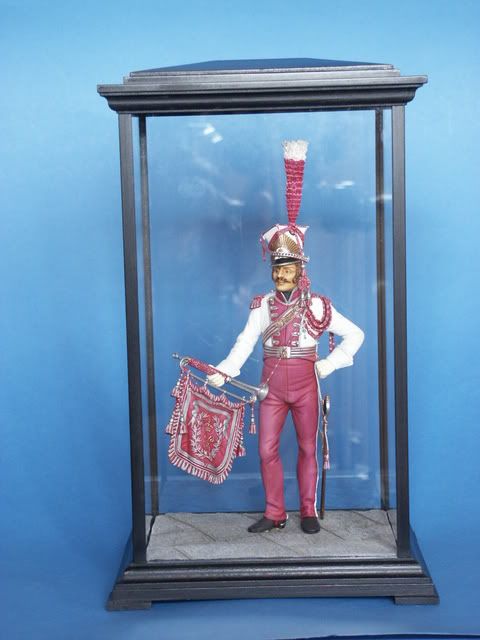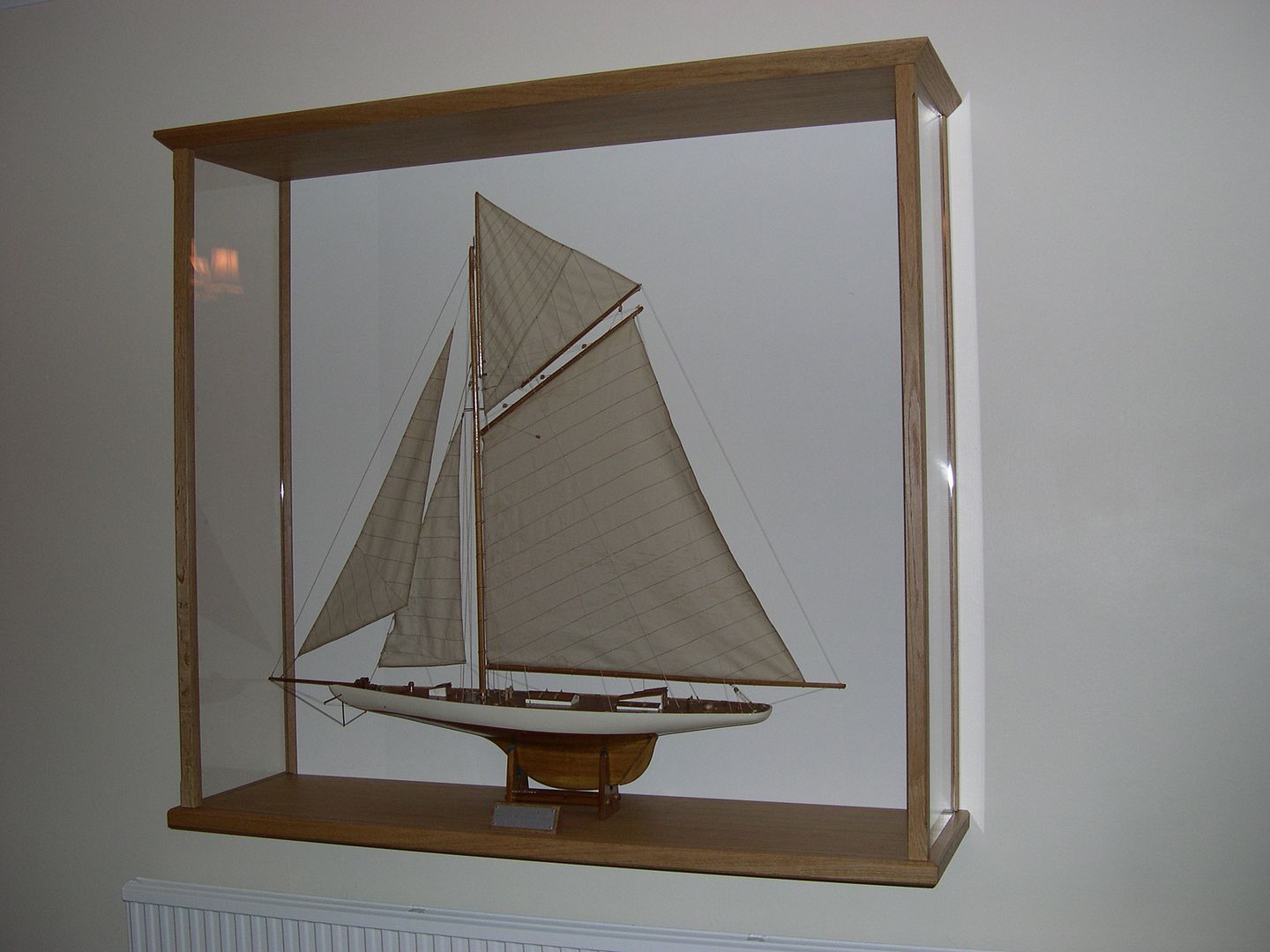Display Case Making
| Martin Kyte | 26/08/2020 19:49:44 |
3445 forum posts 62 photos | Just read the article on making display cases in the latest Model Engineer which seems a very usefull and practical method. The article prompts me to describe my mate Barrie's evolution of case making for his models for those who like glass as a material. Initial attempts used Brass angle silver soldered together at the corners and the glazed with what he always described as 20 pennyweight glass. Picture glass to the rest of us (I guess around 2mm). The main difficulty was setting and holding the brass angle correctly in order to solder the joints. The finished result was acceptable but prone to tarnishing and plain brass angle actually looks a little thin. If you see museum cases they use a much heavier moulded section. The next bright idea was hardwood routed to form an right angled bead ebonised and joined at the corners with fancy brass angle plates screwed in place with small brass woodscrews. Well this looked quite nice on a couple of skeleton clocks but the making of the scroll style corner angles in brass was quite time consuming. Glazing was as before using silicone sealant to attach the glass. Realising how good a bond was created between the glass and the wooden corner beading lead to the final iteration. The corner brackets were done away with and each glass side was fitted with a surrounding edging of hardwood beading with the corners suitably mitred on facing sides and buttted on hidden aspects. The assembly was achieved essentially using the glass to bead bond as the structural strength with no need to rely on the corner joint at all. Much easier to assemble and quite light and strong. The final cases looked really good too. regards Martin |
| Rod Renshaw | 26/08/2020 21:18:39 |
| 438 forum posts 2 photos | Glass sounds better than acrylic to me. Acrylic (Perspex/Plexiglas) looks great when it is new, but it is quite soft and dust, even domestic house dust, is very abrasive. After a few years of energetic dusting, perhaps by SWMBO, acrylic will look scratched and on its way to becoming opaque, and the maker's pride and joy will start to look old and tatty and perhaps SWMBO will want to hide it away, and the next generation will not want it at all. Rod |
| Martin Kyte | 26/08/2020 22:35:04 |
3445 forum posts 62 photos | What interested me was the 3 approaches. 1 Make a frame and glaze it. (relies on corner joints) 2 Make a glazed box and then add decorative beading (panel to panel joints) 3 Hybrid. Panel to bead joints with long adheasive runs making for strength (panel to bead to panel) regards Martin
|
| JasonB | 27/08/2020 07:06:45 |
25215 forum posts 3105 photos 1 articles | I've done it by using silicone to first form a glass box much like a fish tank and then applying a decorative "L" shaped moulding to the external corners, you you are neat with the silicon then the internal corners don't need covering if not a square bead can be added. The glass on this is about 300mm high, various woods that have been ebonized for the trim.
Bigger stuff like this 5ft wide case I route grooves into square columns to take the glass
Edited By JasonB on 27/08/2020 07:07:11 |
Please login to post a reply.
Want the latest issue of Model Engineer or Model Engineers' Workshop? Use our magazine locator links to find your nearest stockist!
Sign up to our newsletter and get a free digital issue.
You can unsubscribe at anytime. View our privacy policy at www.mortons.co.uk/privacy
- *Oct 2023: FORUM MIGRATION TIMELINE*
05/10/2023 07:57:11 - Making ER11 collet chuck
05/10/2023 07:56:24 - What did you do today? 2023
05/10/2023 07:25:01 - Orrery
05/10/2023 06:00:41 - Wera hand-tools
05/10/2023 05:47:07 - New member
05/10/2023 04:40:11 - Problems with external pot on at1 vfd
05/10/2023 00:06:32 - Drain plug
04/10/2023 23:36:17 - digi phase converter for 10 machines.....
04/10/2023 23:13:48 - Winter Storage Of Locomotives
04/10/2023 21:02:11 - More Latest Posts...
- View All Topics
- Reeves** - Rebuilt Royal Scot by Martin Evans
by John Broughton
£300.00 - BRITANNIA 5" GAUGE James Perrier
by Jon Seabright 1
£2,500.00 - Drill Grinder - for restoration
by Nigel Graham 2
£0.00 - WARCO WM18 MILLING MACHINE
by Alex Chudley
£1,200.00 - MYFORD SUPER 7 LATHE
by Alex Chudley
£2,000.00 - More "For Sale" Ads...
- D1-3 backplate
by Michael Horley
Price Not Specified - fixed steady for a Colchester bantam mark1 800
by George Jervis
Price Not Specified - lbsc pansy
by JACK SIDEBOTHAM
Price Not Specified - Pratt Burnerd multifit chuck key.
by Tim Riome
Price Not Specified - BANDSAW BLADE WELDER
by HUGH
Price Not Specified - More "Wanted" Ads...
Do you want to contact the Model Engineer and Model Engineers' Workshop team?
You can contact us by phone, mail or email about the magazines including becoming a contributor, submitting reader's letters or making queries about articles. You can also get in touch about this website, advertising or other general issues.
Click THIS LINK for full contact details.
For subscription issues please see THIS LINK.
Model Engineer Magazine
- Percival Marshall
- M.E. History
- LittleLEC
- M.E. Clock
ME Workshop
- An Adcock
- & Shipley
- Horizontal
- Mill
Subscribe Now
- Great savings
- Delivered to your door
Pre-order your copy!
- Delivered to your doorstep!
- Free UK delivery!












 Register
Register Log-in
Log-in


